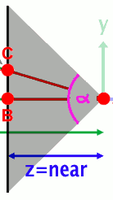Hello there,
I apologize in advance, as i am really not good with math at all, so i'll try to be as specific as i can, to prevent any misunderstandings.
I have a 3D coordinate system with axes X, Y, Z, from -1.0 to +1.0. I have a point somewhere in there, it can be anywhere. I also have an also freely placed viewpoint in this coordinate system, which have three angles Theta X, Y, Z from 0.0 to 359.999... This viewpoint has a 2D viewframe with it's own coordinate system with axes X and Y from -1.0 to 1.0 and i would like to make a function which calculates that 3D point's 2D coordinates in the viewpoint's viewframe.
So, i have p3DX, p3DY, p3DZ, VpX, VpY, VpZ, VpThX, VpThY and VpThZ and from these values, i would like to calculate the resulting p2DX and p2DY.
I've checked this topic on Wikipedia and other forums, but all of the articles/explanations assumes that the reader is adept in high math, so i did not understand those fully.
Anyone can help me in this? Thanks in advance.
I apologize in advance, as i am really not good with math at all, so i'll try to be as specific as i can, to prevent any misunderstandings.
I have a 3D coordinate system with axes X, Y, Z, from -1.0 to +1.0. I have a point somewhere in there, it can be anywhere. I also have an also freely placed viewpoint in this coordinate system, which have three angles Theta X, Y, Z from 0.0 to 359.999... This viewpoint has a 2D viewframe with it's own coordinate system with axes X and Y from -1.0 to 1.0 and i would like to make a function which calculates that 3D point's 2D coordinates in the viewpoint's viewframe.
So, i have p3DX, p3DY, p3DZ, VpX, VpY, VpZ, VpThX, VpThY and VpThZ and from these values, i would like to calculate the resulting p2DX and p2DY.
I've checked this topic on Wikipedia and other forums, but all of the articles/explanations assumes that the reader is adept in high math, so i did not understand those fully.
Anyone can help me in this? Thanks in advance.


